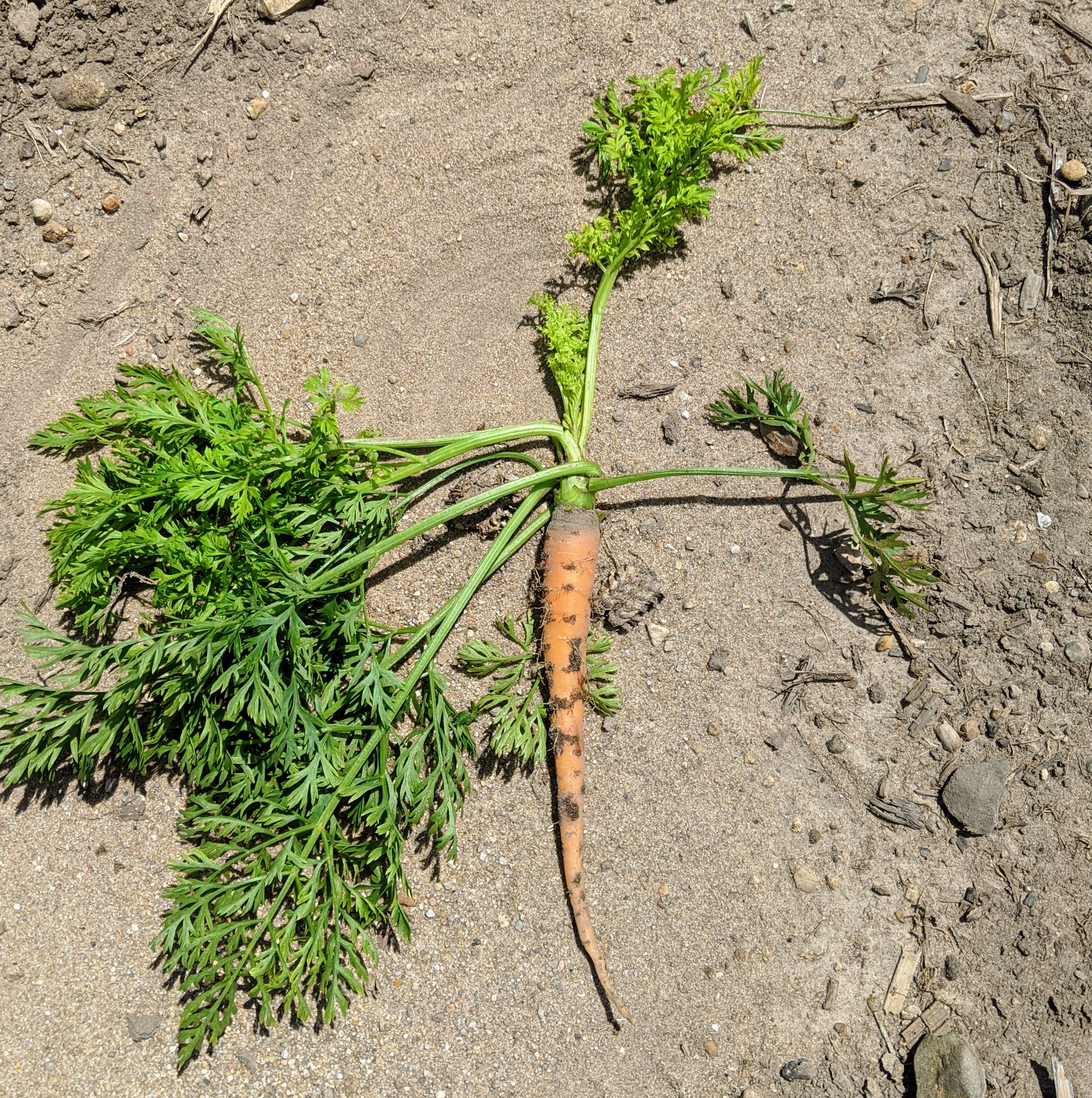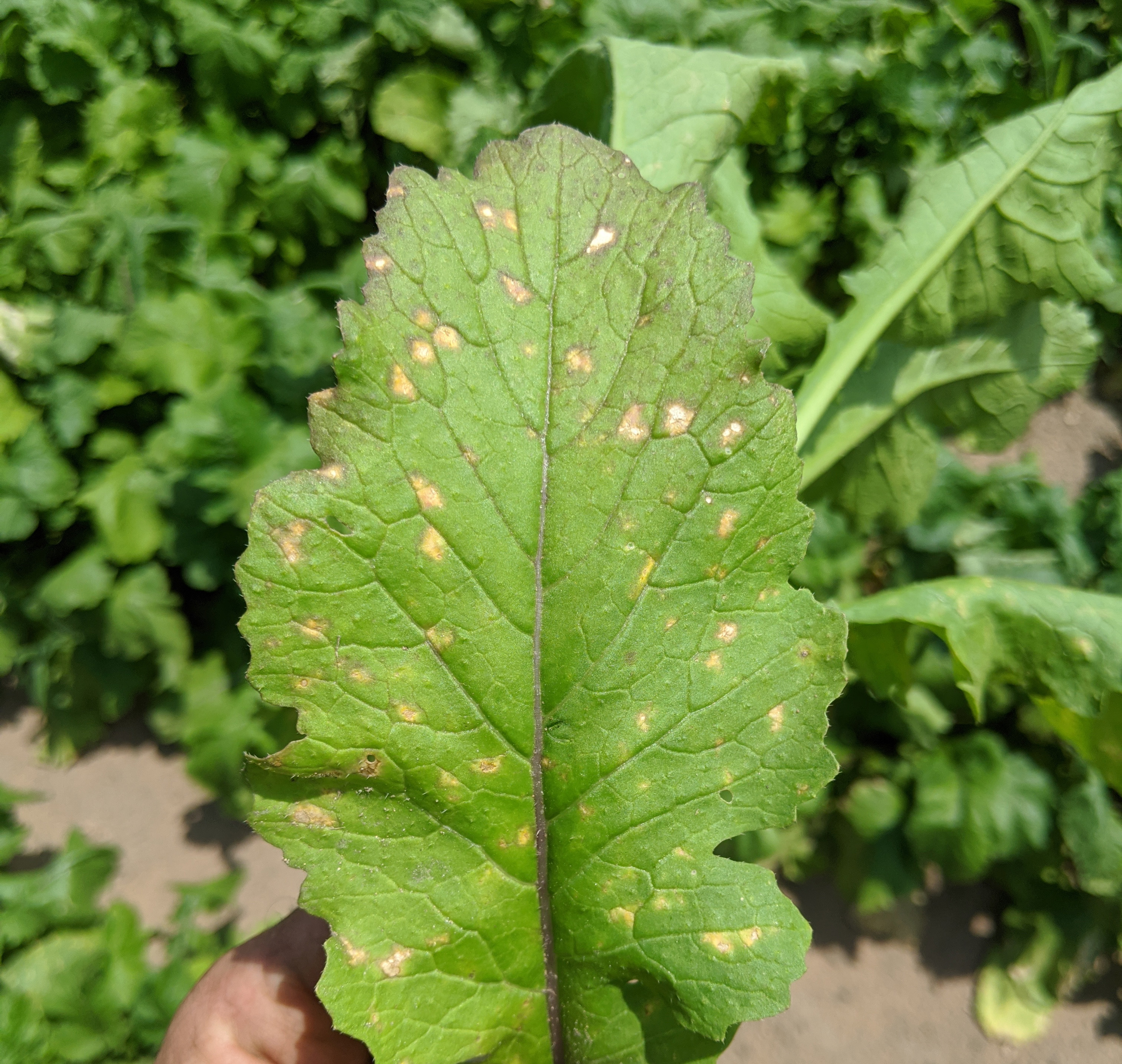West central Michigan vegetable update – July 15, 2020
Stemphylium has been detected in onions. Upcoming weather will be favorable for some foliar diseases.

Weather
Most areas should see 0.25-0.5 inches of rain later today through tomorrow morning, with the highest totals in north central Michigan. There will be daily chances of scattered showers and thunderstorms in the central and southern portions of the state Saturday through early next week. However, rain will be scattered and most areas will remain dry.
Highs will increase to the upper 80s and 90s this weekend through early next week. Dewpoints are forecast in the 70s, with lows the upper 60s and 70s. This will facilitate development of foliar diseases, which up until now have been relatively quiet. Precipitation through next Wednesday, July 22, is forecast to total 0.75-1.5 inches, though this forecast is likely aggressive.
The medium range guidance calls for warmer than normal temperatures for late July through early August. Earlier in this timeframe, we will have weak northwesterly flow, which will bring occasional chances for showers and thunderstorms. This may dissipate towards early August if the broad ridge we are under amplifies and moves the storm track away from us.
Herbicide resistance
Do you have weed populations you feel are herbicide resistant? Sushila Chaudhari has obtained funding through the Michigan Vegetable Council to screen for herbicide resistance. Read her article, “Screening of herbicide resistant weeds in Michigan vegetable fields,” and get in touch if you would like to have seed collected for resistance screening.
Crop updates
Asparagus growers should apply foliar fungicides if they have not already, or if it has been some time since the first cover (Photo 1). This weekend will see high dewpoints and warm overnight temperatures, which will facilitate development of purple spot. Chlorothalonil or mancozeb can provide protection against purple spot, and tebuconazole is helpful for rust. If you have TomCast meters, these can provide a more accurate guide.
Carrot growers were initiating fungicide programs in west central Michigan. Disease severity values (DSVs) were accruing over the last week at one Oceana County location I am monitoring, with 12 DSVs accumulating from July 6-13. Depending on when your initial cover was applied, it may be time to make a second application. As the season progresses, remember that DSVs can help inform product choice. Daily DSV values of 3 or more indicate weather is especially conducive for disease. Streaks of multiple 3+ DSV days indicate especially good disease weather. Luna Tranquility or Merivon are highly effective fungicides that could be considered at these times. Aster yellows symptoms were visible on scattered carrots over the last two weeks. These include distorted new growth and slightly hair roots (Photo 2).

Celery scouts report that initial infestations of aphids were well controlled by Movento. On one farm I visited, evidence of past damage was present but aphids were dead. Scouts did report a jump in variegated cutworm trap captures in southern Michigan recently. Check your scouting report in the coming three weeks as increases in trap catch generally progress from south to north over time. Aster leafhopper numbers have been low in recent weeks.
Cole crop growers struggling with black rot (Photo 3) this year will need to practice some not-so-fun “applied epidemiology.” Try to avoid spreading it from symptomatic areas to other brassicas. As a bacterium, this disease cannot move on its own. It needs to be moved by people or equipment. Avoid working fields when they are wet. Second, do any work in problem fields after your clean fields. Powerwash equipment with soapy water afterwards. Next, consider applying a good copper product weekly to provide some protection for uninfected plants and foliage (applications at longer intervals are not worthwhile). Kocide 3000 or Kocide 3000-O (OMRI listed) have a high metallic copper content and could be considered. Note, experience suggests that copper can cause unacceptable cosmetic injury on cabbage once it starts heading. Make sure to take notes on which varieties you see initial problems in, and do not save seed of that variety for next year.
Finally, put a big sticky note somewhere for next year, reminding yourself to start intensive copper applications early in the transplant greenhouse, as this is the place you can do the most good.
.jpg?language_id=1)
Downy mildew was detected in Ottawa County turnips last week (Photo 4). Presidio is labeled for turnips and carries downy mildew on its label.

Cucurbit downy mildew has been detected in Berrien, Monroe, Sanilac and Washtenaw County cucumbers. It has also been detected in Canada and Ohio. Cucurbit powdery mildew was present in an early planting of vine crops in Ottawa County this week. Squash bug egg masses were also visible at an Ottawa County location. Squash mosaic virus was detected in zucchini on the east side of the state. Plants had distorted foliage and bumpy fruit.
Onions with Stemphylium leaf blight were detected over the past week, so this disease has made its appearance. It will be critical to have a good fungicide on with the high dewpoints and temps coming over the weekend. Luna Tranquility, Miravis Prime, Omega or Tilt could be products to consider. One effective rotation could be:
- Luna Tranquility or Miravis Prime alternated with
- Bravo Weatherstik and then…
- Tilt plus mancozeb
Rinse and repeat!
Movento has performed well at locations I am monitoring for thrips, even with the recent heat. If thrips populations warrant, consider reserving Radiant until we get into our hot, upcoming weather. Thrips populations could rebound after being quieter due to Movento, and Radiant is the only effective knockdown we have for high populations. Otherwise, I’d strongly suggest giving Cornell University’s onion thrips management guidelines for 2020 a read, as they lay out a weekly program that can be adapted based on thrips populations.
Pepper growers should be aware that the second flight of European corn borer is expected to begin in the next week, based on degree days at the Hudsonville and Standale Enviroweather stations. Degree day accumulations in Kent City and Hart suggest the second flight is about one to two weeks away at those more northern spots. Proactive growers should initiate a European corn borer program by late July if they do not have traps to help time initial applications. Based on work at Ohio State, a second-tier product can be used for the first application or two, as August is European corn borer go time.
If you are battling thrips, it will be critical to avoid applying a broad spectrum product like Lannate or a pyrethroid now, as this will make problems far worse. These products kill the minute pirate bugs that help keep thrips in check. Avaunt, Intrepid or Radiant are narrow spectrum alternatives for your first European corn borer spray. Radiant is also the best thrips material we have for peppers, so do not use up your applications unless you need to.
Coragen is a highly effective European corn borer material that can be used for August sprays, when European corn borer is most active. Put another way, it is a good substitute for the weeks Orthene usually appears in your rotation. Later on in the season, broad spectrum materials such as Mustang Maxx can be used. By this time, the major fruit sets will likely be past, and there will be less time for thrips populations to increase and cause issues.
Tomato growers should be on a good foliar disease program. Bravo can be alternated with Quadris (active ingredient azoxystrobin) or its generics on a weekly interval to protect against the major foliar, fungal diseases.
Sweet corn growers should be protecting silking corn. I captured modest numbers of corn earworm at an Oceana and Ottawa County trap this week. At these locations, a spray interval of five days is appropriate given the low trap catches. Remember that hot weather makes silks grow faster, so repeat coverage may be needed more frequently than when it is cooler. Affordable pyrethroids can be used when trap catches are low. Western bean cutworm has also been flying but should be cleaned up by your corn earworm sprays.
The next flight of European corn borer is predicted to begin next week, based on degree days at the Hudsonville and Standale Enviroweather stations. The best predictor of problems is pressure in your early corn. If you saw significant populations feeding in whorls and boring in tassels or stalks, it suggests you have a local population. Thankfully, a prompt application of a pyrethroid at tassel emergence is sufficient if you are following this up with your corn earworm program.



 Print
Print Email
Email

